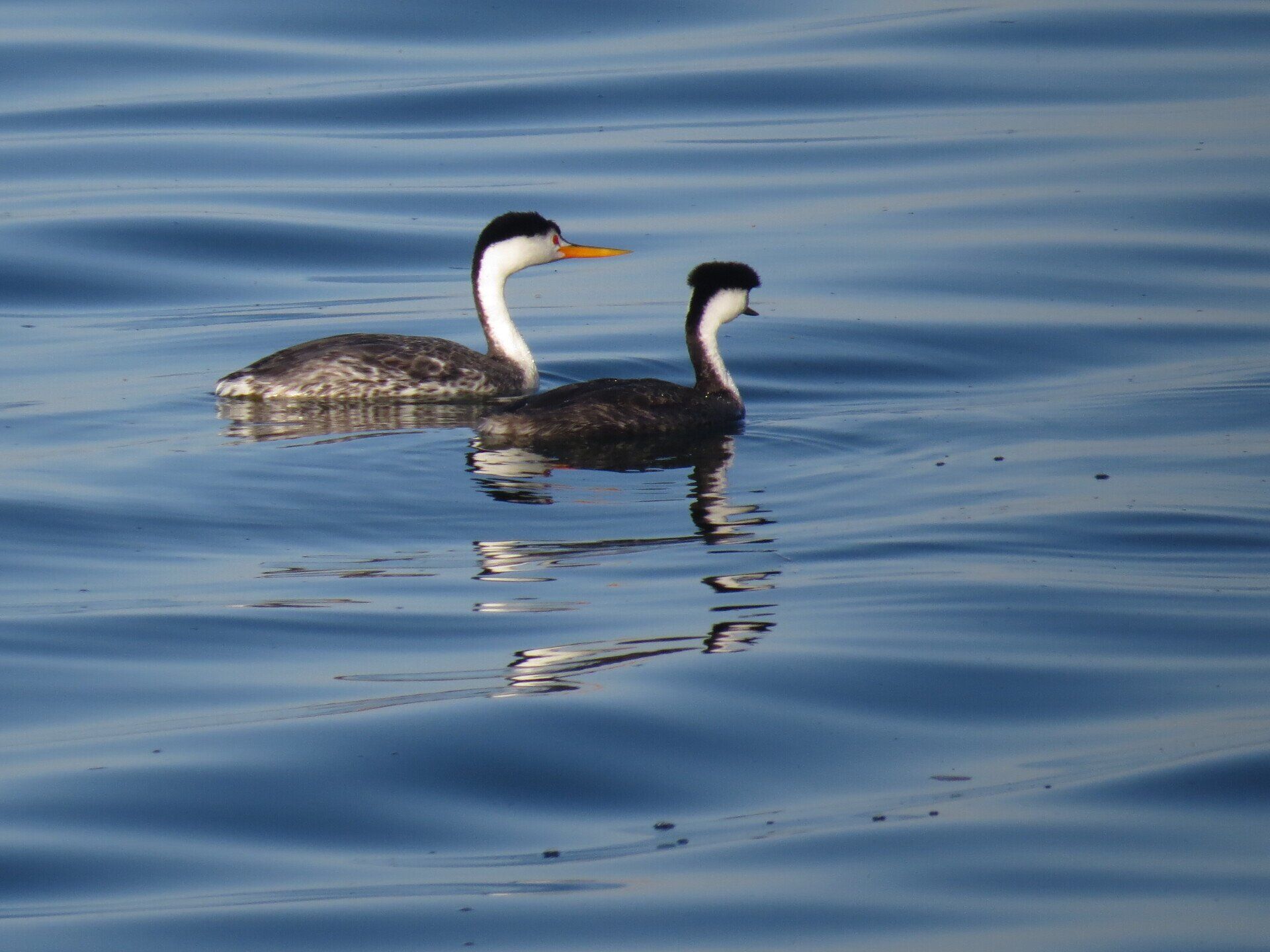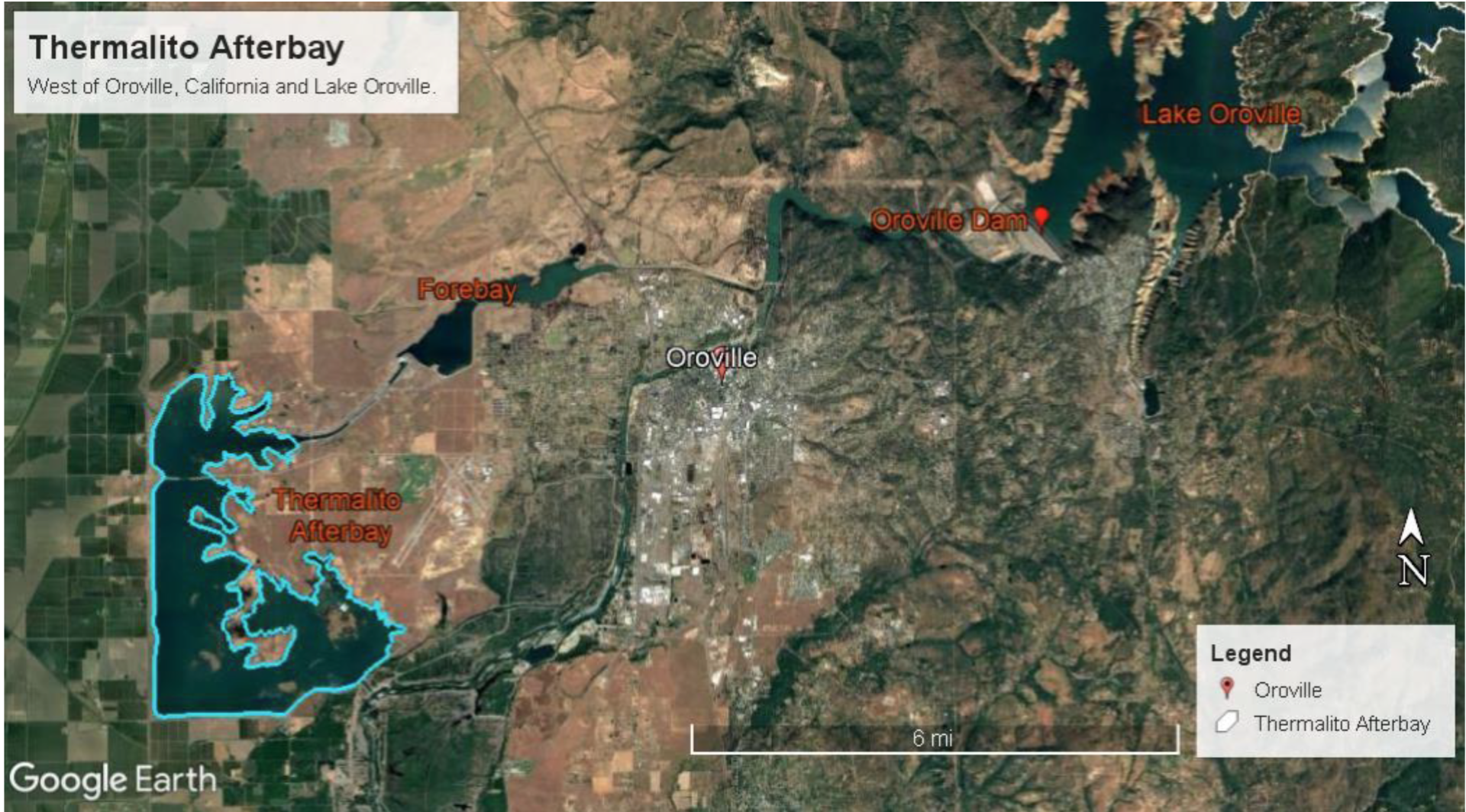
Grebe Surveys, Monitoring, and Educational Programs
Conservation of Aechmophorus Grebe Colonies at Thermalito Afterbay
Survey & Monitoring Final Report 2010-2020
Education & Outreach Final Report 2010-2020
Altacal Audubon Society began surveying and monitoring the Clark’s and Western Grebes on Thermalito Afterbay (Oroville, CA) in 2010. We worked under a grant that extended for 10 years under administration by Audubon California and the Luckenback Council. Altacal coordinated monitoring and surveys with the Department of Water Resources (DWR) and the California Department of Fish and Wildlife (CDFW).
Production Surveys
The production surveys were conducted to get a total individual grebe count (adults and young) on Thermalito Afterbay. Ryan Martin (DWR) developed a route to survey by boat that attempted to cover the entire Afterbay (see map). This route was used year after year to ensure consistency in the data collection. Most years, all individuals were counted and identified as Western Grebes, Clark’s Grebes, or unknown Aechmophorus grebes (if they were too far away for identification or if they dove after a brief glimpse). Numbers of adults and young were also recorded.
Nest Initiation Surveys
Nest initiation surveys were conducted from shore using binoculars and spotting scopes, by canoes/kayaks or motorboat in known historic breeding colonies, starting around June 1 each year. Nesting occurs from late May through mid-September on Thermalito Afterbay. Weekly surveys up until nest initiation were not possible every year, and thus nest initiation surveys began based on historic nest initiation dates. If nest initiation was missed, it was estimated based on the first chicks seen hatching or on the size of the oldest chicks observed during the first brood survey.
Nest Monitoring Surveys
Thermalito Afterbay nest monitoring surveys were conducted by Mud Buddy boat or kayak. Nest monitoring was conducted before noon, whenever possible, as this was when adults were most likely to be on their nests. At each site, all obvious nests of Aechmophorus grebes were counted. Nests that appeared to be actively maintained or being built were noted but not included in the final estimates of active nests.
Although most nesting occurs in historic breeding colonies, full lake surveys were also conducted to determine whether there were any new nesting areas not previously documented. Once nesting began, discrete nesting areas were considered colonies, defined by proximity to the main coves. The surveys were conducted for nest colonies in open water and also for colonies in dense vegetation such as willows, cattails, or tules.
Population and Brood Surveys
Population counts and brood surveys were conducted by motorboat or kayak. Brood surveys started after young were first observed on a lake and were repeated one or two times a month until the end of September. Population/brood counts required at least two surveyors, one data recorder, and one boat driver. Clark’s and Western Grebes were identified when possible or otherwise counted as Aechmophorus grebes. The survey route was tracked with GPS, and the start/end points of transects were marked as GPS waypoints. The ratio of young to adult grebes was calculated per survey. Population counts were conducted during brood surveys to obtain a census of the entire grebe population on the lake.
Data Summaries
Each year was summarized in the final report and includes the average number of individuals observed, the reproductive success (productivity), and a chart of the water level fluctuations, with dates of nest initiation, peak nesting, and last nest observed.
Public Education Program
Altacal Audubon Society began an effort to educate the public about the grebes on Thermalito Afterbay (Oroville, California) in 2010 and continued with the help of a grant until 2020.
Western and Clark’s Grebes breed on the Thermalito Afterbay (TAB), and their reproductive success had been adversely affected by several factors, including fluctuating water levels (due to water management), boaters, water skiers, and predators. Our goal was to educate people about these amazing water birds and instill an understanding of their importance. We educated lake users on how everyone can help the grebes thrive by avoiding their nesting colonies, reducing boat speed near their nests (so they don’t get flooded or have the eggs washed out), and giving space to the grebes while they are foraging.
Thermalito Afterbay is part of the Oroville Dam Complex (see map) and ranks as the fifth most important breeding site for grebes in California, supporting approximately 100 to 240 pairs of Western and Clark’s Grebes during the course of this study.
Aechmophorus
grebes have nested at Thermalito Afterbay for at least 20 years, but no efforts had been made to consistently count individuals or monitor breeding success until the Department of Water Resources began conducting surveys in 2003. Since 2010, the surveys have been conducted in partnership with Altacal Audubon Society and Audubon California’s Grebe Conservation Project.
Map 1: Oroville Dam Complex Map highlighting the Thermalito Afterbay (TAB)
From initial conversations with CDFW and DWR it appeared that dramatic fluctuations in water levels and human disturbance from waterskiing were the most obvious threats causing nest abandonment and reduced breeding success. Since water level change restrictions were already in place and had agency oversight, we determined that education and outreach could help reduce disturbance from waterskiing and fishing boats. For this, we took to the field.
The Thermalito Afterbay is a heavily used water body for fishing boats, jet skis, and water skiers. Most of the users were local boat owners that frequented the Afterbay consistently throughout the summer. Altacal Audubon made a great effort to build an educational relationship with these return users by setting up a grebe booth at the major boat ramps: Larkin Road launch, Monument Hill launch, and Wilbur Road boat launch on the weekends during the spring and summer months.
Our consistent presence led to a greater acceptance of the TAB grebes, individuals, and colonies. We conveyed our conservation message using a variety of tools including large, engaging posters of the grebe’s flashy behaviors: dynamic courtship displays, building floating nests, and carrying young on their backs.
Altacal Audubon Society Inc. is a tax-exempt 501(c)3 nonprofit organization dedicated to promoting the awareness, appreciation, and protection of native birds and their habitats, through education, research, and environmental activities.




